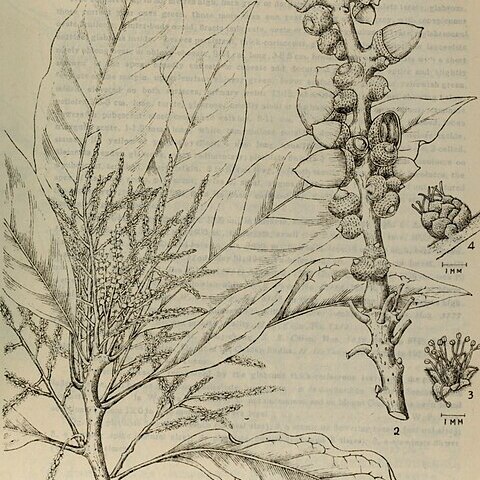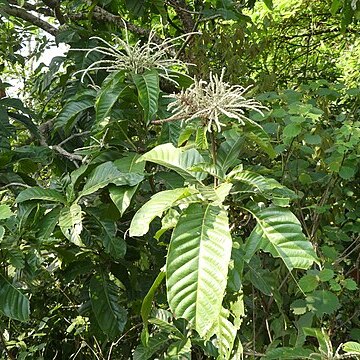Tree 5-30 m, 20-70 cm ø; bark greyish brown, deeply fissured, lenticellate. Branchlets glabrous, greyish brown, sparsely to densely lenticellate; terminal buds ovoid, 2-5 by 2-3 mm, scales narrowly ovate to linear, densely yellowish brown stellate hairy, glabrescent. Stipules narrowly ovate to linear, 3-6 by 1-2 mm. Leaves thick-coriaceous, rigid, (9-)12-17(-20) by (3-)4-6(-8) cm (index (1½-)2-3(-5)), broadest at or above the middle; surfaces glabrous, concolorous, glossy, pale to dark chocolate-brown; base acute, rounded to (extra-Mal.) auriculate, margin recurved, top bluntly acute to 1-2 cm acuminate; midrib strongly prominent beneath, slightly so to flat above; nerves (10-)12-15(-18) pairs, prominent beneath, obscure above, subparallel at an angle of 45-60°, arcuating and anastomosing near the margin; reticulation subscalariform to irregular, fine, obscure to distinct beneath; petiole ⅓-2½ cm, 1-2 mm ø, adaxially flat, glabrous, occasionally thickened at the base. Inflorescence sturdy, male, androgynous or rarely mixed, densely fulvous simple and stellate hairy; bracts and bracteoles ovate-acute, 1-2 by 1 mm. Male rachis 10-30 cm, 2-3 mm ø, sometimes much-branched; ♂ flowers in clusters of (3-)7-15(-24), filaments 2½-3 mm, anthers 0.3 mm long, pistillode subglobose, 1-1½ mm ø. Androgynous or mixed rachis 15-30 cm, 2-3½ mm ø; female flowers in clusters of (3-)5-7(-10), staminodes rudimentary, styles 3, terete, ⅔-1 mm. Fruiting rachis up to 30 cm, carrying numerous clustered cupules. Ripe cupule sessile to ½ cm stalked, cup-to saucer-shaped, (¼-)½-1(-2) cm long, (1-)2-3(-3½) cm ø; rim thin to rather thick, covering ¼-⅓ part of the fruit; wall woody, inside densely yellowish brown tomentose by simple adpressed hairs, outside densely fulvous adpressed stellate hairy; scales adpressed, sometimes rather woody, distinct but not free, imbricate to more or less concentrically set. Ripe fruit ovoid-conical to depressed ovoid-globose, (1-)1½-2(-2½) cm long, (1-)2-2½(-3½) cm ø, glabrous, chocolate-brown, top abruptly rounded acute to rounded and depressed at the centre, base rotun-date, scar flat to concave, ¾-1½ cm ø; wall woody, c. 1 mm thick, for the greater part free from the cupule.
More
A small evergreen tree. It grows 4-16 m tall. The leaves are alternate and simple. The leaves have stalks. The leaves are 8-35 cm long by 3-10 cm wide. They are oval or sword shaped. They taper to the tip. They are leathery. The base is wedge shaped or rounded. The flowers are 3 mm across. They are yellowish and occur in clusters. The fruit is an acorn. It is 18 mm across and greenish. It has a cup at the base.


